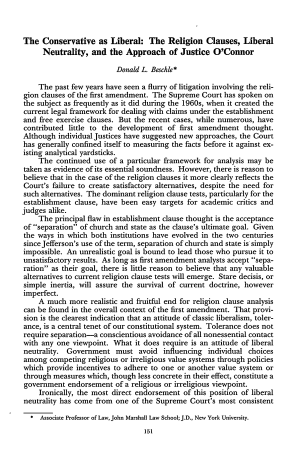The Conservative as Liberal: The Religion Clauses, Liberal Neutrality, and the Approach of Justice O'Connor
January 1, 1987

DISCLAIMER: This text has been transcribed automatically and may contain substantial inaccuracies due to the limitations of automatic transcription technology. This transcript is intended only to make the content of this document more easily discoverable and searchable. If you would like to quote the exact text of this document in any piece of work or research, please view the original using the link above and gather your quote directly from the source. The Sandra Day O'Connor Institute does not warrant, represent, or guarantee in any way that the text below is accurate.
Article Text
(Excerpt, Automatically generated)
The Conservative as Liberal: The Religion Clauses, Liberal Neutrality, and the Approach of Justice O'Connor
Donald L. Beschle *
The past few years have seen a flurry of litigation involving the reli gion clauses of the first amendment. The Supreme Court has spoken on the subject as frequently as it did during the 1960s, when it created the current legal framework for dealing with claims under the establishment and free exercise clauses. But the recent cases, while numerous, have contributed little to the development of first amendment thought. Although individualjustices have suggested new approaches, the Court has generally confined itself to measuring the facts before it against ex isting analytical yardsticks.
The continued use of a particular framework for analysis may be
taken as evidence of its essential soundness. However, there is reason to believe that in the case of the religion clauses it more clearly reflects the Court's failure to create satisfactory alternatives, despite the need for such alternatives. The dominant religion clause tests, particularly for the establishment clause, have been easy targets for academic critics and judges alike.
The principal fl.aw in establishment clause thought is the acceptance of "separation" of church and state as the clause's ultimate goal. Given the ways in which both institutions have evolved in the two centuries since Jefferson's use of the term, separation of church and state is.simply impossible. An unrealistic goal is
